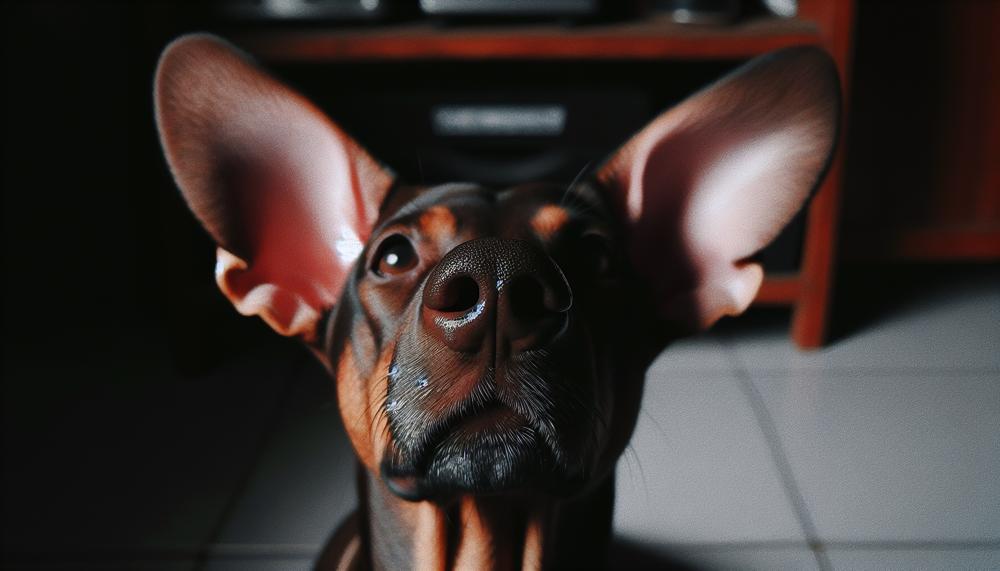Imagine strolling down the street and spotting a dog with one ear perched high while the other droops down. It’s an ordinary occurrence, yet have you ever pondered why only one ear stands up on dogs?
Believe it or not, there’s a scientific rationale behind this seemingly peculiar trait. In this blog post, we’ll delve into the captivating world of canine anatomy and behavior to uncover the mysteries of this curious phenomenon.
Here are some key points to bear in mind:
- Dogs possess 18 muscles in each ear, granting them a vast range of motion.
- The shape and size of a dog’s ears can influence their standing position.
- Genetics play a significant role in determining which ear stands up.
- Environmental factors like temperature and sound can also impact ear placement.
- Certain breeds are more likely to have both ears standing up, while others are renowned for their “one-up-one-down” appearance.
So why does only one ear stand up on dogs? Let’s unravel the truth.
What does it mean when a dog has one ear up and one down?
Table of Contents
Dogs can often be seen with one ear up and one ear down, leaving many to wonder what this means. While it may seem odd, there are actually several reasons why a dog may have this ear posture.
Let’s explore some of the potential causes:
- Developmental stage: Puppies are known for their floppy ears, as their ear muscles are not yet fully developed. As they grow and mature, their ears will eventually stand up on their own. However, this process can vary in length, and it’s not uncommon for one ear to stand up while the other remains down for a longer period of time.
- Genetics: Some breeds, like German Shepherds and Corgis, are genetically predisposed to having one ear up and one ear down. This is a natural trait that is passed down from their parents.
- Health conditions: In some cases, a dog’s ear may remain down due to an underlying health condition. Ear infections, blood clots, yeast infections, and injuries can all cause one ear to droop. If you notice your dog’s ear staying down for an extended period of time or if it is accompanied by other symptoms, such as discharge or redness, it is essential to consult a veterinarian for proper diagnosis and treatment.
- Listening intently: Dogs have incredible hearing abilities and may tilt their head or keep one ear down to better hear a sound or signal. This behavior is entirely normal and nothing to be concerned about.
- Injury or trauma: Dogs can also have one ear down due to injuries or trauma. This could result from accidents, fights with other dogs, or rough play. In these cases, the dog’s ear will likely stand up again once the injury has healed.
- Medications: Some medications can cause a dog’s ears to droop as a side effect. If your dog is on any medications and you notice their ears staying down, consult with your veterinarian to see if there is an alternative medication that can be prescribed.
When to take your dog to the vet
It’s important to keep a close eye on your dog’s standing ear and watch for any accompanying symptoms that may warrant a trip to the vet.
These can include signs of discomfort or pain, such as flinching or yelping when you touch their ear, which could be indicative of an infection or injury. Redness and swelling around the base of the ear may also be a cause for concern, as it can be a sign of inflammation, infection, or trauma.
Additionally, if you notice any discharge coming from your dog’s ear, it’s crucial to seek medical attention as it could be a sign of infection that requires treatment. Changes in behavior, like excessive scratching or rubbing of the ear, are also red flags that something may be wrong and should be addressed by a veterinarian.
Keep in mind that every dog is unique and some dogs may naturally have one standing ear without any underlying medical issues. However, if you are unsure or notice any concerning symptoms, it’s always best to consult with a veterinarian for proper diagnosis and treatment.
After all, our furry friends can’t tell us when something is wrong, so it’s up to us to pay close attention and seek medical help if necessary.
When to clean your dog’s ears
Your canine companion’s ears are a crucial aspect of their overall health and well-being. Keeping them clean is vital to prevent any potential infections or other issues that could arise. However, the frequency at which you should clean your dog’s ears depends on factors such as breed, coat, activity level, and ear wax production.
Typically, it is recommended to clean your dog’s ears once a month. However, if your furry friend loves to take a dip in the water or has a thick coat, you may need to clean their ears more frequently. Swimming can introduce water and debris into the ear canal, while a thick coat can trap dirt and wax, increasing the risk of ear problems.
You may wonder if cleaning your dog’s ears more often would help if one ear stands up while the other flops over. The answer is not necessarily. A standing ear is usually a genetic trait or a result of an injury. However, keeping your dog’s ears clean can prevent potential infections or irritations that could cause discomfort and affect the standing ear.
To effectively and safely clean your dog’s ears, it is essential to gather your tools beforehand and ensure your furry friend is comfortable. You can use a soft cloth or cotton balls dampened with an ear cleaner recommended by veterinarians to gently wipe away any visible wax or debris from the outer part of the ear. Avoid using cotton swabs as they can push debris further into the ear canal and potentially damage the eardrum.
| Factors to consider | Recommended frequency of cleaning |
| Breed | Once a month |
| Coat thickness | Once a month; more frequently if your dog has a thick coat or is prone to trapping dirt and wax |
| Activity level | Once a month; more frequently if your dog loves to swim |
| Ear wax production | Once a month; more frequently if excessive ear wax production is observed |
To ensure your furry friend’s ears stay clean, it’s important to keep these factors in mind and adjust the cleaning frequency accordingly. Remember, taking care of your dog’s ears is an essential part of being a responsible pet owner.
Dog breeds with floppy ears
Canine breeds with droopy ears are commonly known as “drop-eared” or “pendulous” ears, where the ears hang down and cover the ear canal. This creates a warm and cozy environment for bacteria and yeast to thrive, making regular ear cleaning essential to prevent infections.
Some popular dog breeds with floppy ears include the Beagle, Basset Hound, Coonhound, Bloodhound, Afghan Hound, English Cocker Spaniel, Poodle, and Setter.
Beagle:
- Originating from England, the Beagle is a small scent hound renowned for its keen sense of smell and droopy ears.
- Their long, flopping ears serve a practical purpose by trapping scents and directing them towards their nose for tracking.
- Due to their lengthy and pendulous ears, Beagles are prone to ear infections and require frequent cleaning to maintain healthy ears.
Basset Hound:
- The Basset Hound is another scent hound with long, droopy ears originating from France.
- Their large ears act as a “radar dish,” aiding in picking up scents from the ground while hunting.
- However, their floppy ears also make them susceptible to ear infections, making regular cleaning crucial.
Coonhound:
- As their name suggests, Coonhounds were initially bred for hunting raccoons and other small game.
- Their long and drooping ears serve as protection from thorns and brush while navigating through the woods.
- However, their floppy ears also tend to trap moisture, increasing the risk of ear infections.
Bloodhound:
- The Bloodhound is a large scent hound with drooping ears originating from Belgium.
- Their lengthy and wrinkled ears possess a functional purpose by collecting scent particles and directing them towards their nose.
- However, due to their long and pendulous nature, they are prone to ear infections and require regular cleaning.
Afghan Hound:
- Originating from Afghanistan, the Afghan Hound is a breed known for its long, silky coat and drooping ears.
- Their floppy ears serve a functional purpose by shielding their delicate inner ear when hunting in harsh terrain.
- However, their ears also tend to trap debris and moisture, making them prone to ear infections.
English Cocker Spaniel:
- The English Cocker Spaniel is a breed with long, drooping ears initially bred for flushing out game birds.
- Their floppy ears act as protection while maneuvering through dense brush and undergrowth.
- However, their lengthy ears tend to trap moisture and require regular cleaning to prevent infections.
Poodle:
- Poodles are famous for their curly, hypoallergenic coat and lengthy, droopy ears.
- Their ears serve both a functional and aesthetic purpose, as their drooping nature protects their inner ear while giving them a signature appearance.
- However, their floppy ears also make them prone to ear infections and necessitate regular cleaning.

Why do puppies have floppy ears?
Puppies are born with ears that flop over because their ear cartilage has not yet fully developed or hardened.
As they grow, their ears will usually begin to stand up on their own, but the timing can vary depending on the breed and the individual puppy.
Possible Causes of Floppy Ears in Puppies:
- Genetic Factors: Some breeds, such as Basset Hounds, Bloodhounds, and Cocker Spaniels, are naturally more likely to have floppy ears due to genetics and selective breeding for specific physical traits.
- Ear Development: During the first few months of a puppy’s life, their ear cartilage is still soft and flexible. As they mature, the cartilage will gradually harden and provide support for their ears, causing them to stand up.
- Teething: Puppies experience a teething phase where their bodies require calcium for tooth development. This can impact the growth of their ear cartilage, resulting in floppy ears until the teething process is complete.
- Injury or Infection: In rare cases, a puppy’s ears may become floppy due to an injury or infection. This can cause inflammation in the ear, making it difficult for the cartilage to maintain its upright position.
When Can You Expect Puppy Ears to Stand Up?
The timing of when a puppy’s ears will stand up varies depending on factors such as breed, genetics, and individual development. On average, most puppies’ ears will start to stand up between 8-12 weeks of age.
However, some breeds may take longer for their ears to stand up, while others may have permanently floppy ears.
Here is a table showing typical ear development timelines for popular dog breeds:
| Breed | Ear Development Timeline |
| Basset Hound | 8-12 weeks |
| Beagle | 8-12 weeks |
| Bloodhound | 3-4 months |
| Cocker Spaniel | 8-12 weeks |
| Dalmatian | 6-12 weeks |
| German Shepherd | 5-6 months |
| Labrador Retriever | 5-6 months |
| Poodle | 8-12 weeks |
| Rottweiler | 5-6 months |
| Siberian Husky | 3-4 months |
Also Read: Why Dog Suddenly Being Destructive?
Conclusion
In conclusion, the enigma of why only one ear stands up on our canine companions can be attributed to a variety of factors.
With 18 muscles in each ear, dogs possess an impressive range of motion, allowing for one ear to stand while the other remains floppy. The shape and size of a dog’s ears, along with genetics and environmental influences, can also play a role in their standing position.
While some breeds are more likely to have both ears standing up, others are known for their charming “one-up-one-down” appearance. It is crucial to monitor your dog’s ear health and seek medical attention if any issues arise.
Puppies are born with soft cartilage in their ears, but as they grow and develop, their ears will eventually stand up on their own.






